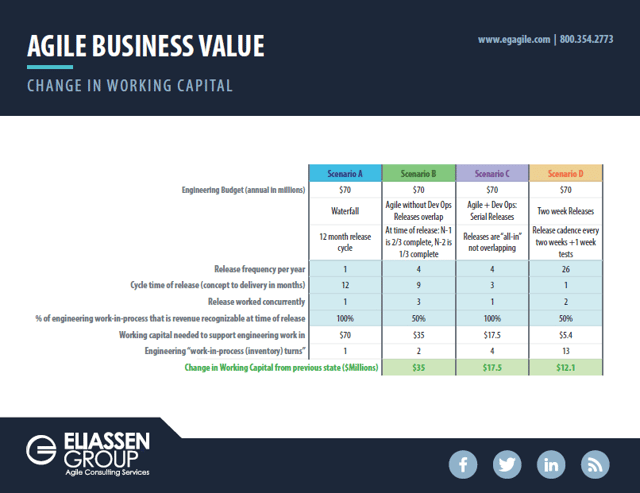Agile Delivery of business value incrementally with a minimal amount of development work-in-progress (inventory) with such a short cycle time between plan and delivery that changes in market, technology, and legislation are immediately responded to with near zero “excess,” near zero “obsolescence,” and less “working capital” (cash) needed to keep the engineering machine running. So what does it mean to be an Agile CFO?
Compare today’s agile transformations with the manufacturing and supply chain transformations of the 90s. Companies have documented substantially better quality, predictability, productivity, and responsiveness from both.
With the substantial reduction in Agile cycle time between planning and delivery, the amount of working capital needed to fund work-in-progress is reduced substantially, and savings can reach the tens of $ millions.
Below I present several scenarios through which a company will progress as they implement an agile transformation, initially with annual releases and waterfall process through several scenarios, to Agile with two week releases. I invite you to inspect the value that may be recognized and share your thoughts. Click on the image below to enlarge the table:

Another key factor that CFOs must consider when evaluating the meaning of business Agility is the impact on the business related to de-risking the income stream and standing by the organization’s fiduciary responsibility to its shareholders.
Agile CFO Practices
When a large development program goes south, it often goes south in a very big way. According to Standish, 29% of large software development programs occurring between 2011-2015 are total disasters with nothing delivered and another 60% are late and over budget with a substantial number of unhappy customers. This leaves only 11% that are successful with an expected return on investment.
For products that have a software component, a missed software release translates to a missed or delayed product release which can be devastating in a competitive marketplace. Software delivery using Agile substantially de-risks a company’s income stream. When you look at the big picture, Business Agility clearly enables a company to compete more effectively, driving market share. Read on for a Q&A to learn more about how.
Q: How does Agile de-risk a large program?
A: With Agile in place, we benefit from the decomposition and continuous re-planning of multiple smaller deliverables, and then incremental delivery of the highest business value with short, sustainable lead times. Accurate capacity planning improves through many data points of demonstrated delivery and improvements to estimates and predictability with every delivery.
Q: How do Agile CFO practices address final regression testing and release requirements?
A: Modern development operations practices focus on collective team ownership of automated integration and predictable short cycle deployments. Many applications with modern development, test, and production ecosystems have demonstrated a release cadence of multiple times per day.
Q: How does Agile CFO practices align business and technical goals?
A: Business people work with technical people on a daily basis. The Scrum Master reinforces the roles: business people determine “the what,” and the technical people determine “the how” and “how much.” The Scrum Master also facilitates team speed and happiness.
Q: How might Agile miss a release date?
A: A release date might be missed when proven Agile practices are violated. When management commits to release content instead of the teams, it is done without full information. The most common reason this occurs is because managers estimate and commit to fixed content instead of the team doing the work. The second major reason this happens is because the business continually interrupts a team with new priorities, compromising the team’s ability to deliver on its sprint commitments.
Q: What are the major obstacles of implementing Agile?
A: Functional areas have optimized efficiency over the many years of their existence. In many cases, this meant batching work. Alternatively, Agile focuses on “flow” of small work items from definition through delivery with small teams. Because there is a high frequency of delivering work, the teams have opportunities to identify and remove impediments regularly, speeding velocity.Clearly, this is a major shift in thinking and practice.
Q: After the teams demonstrate predictable delivery, how does Agile deliver even greater value?
A: This is where the business comes in – working from strategy down, it’s the plan, the re-prioritized backlog of the highest value work that enables an Agile company to leapfrog competition and to continually gain market share.
Q: What can senior executives do to help?
A: Get involved, learn about Agile, celebrate delivery success with the teams, and celebrate outcomes with the business. Also, recognize there may be high level organizational impediments that you can assist with:
HR – Consider more team performance and delivery based motivators rather than individual heroics.
Finance – Insist on justification of investment based on the flow of work through the system.
Purchasing – Contracts with suppliers should be aligned with milestones, planning, and integration of Agile programs.
Facilities – This group is often involved in co-location of teams and open space to enhance communications.
Quality Assurance, Audit, UAT – Require increased and early involvement with the teams.
Development Operations – Consider increased investment in automation, modern tool sets, and continuous feedback.
Do you have questions about Business Agility? We’d be happy to help! Reach out to me directly at bellis@eliassen.com.